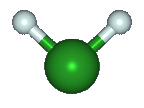|
Protonated hydrogen chloride or chloronium (H2Cl+) was
identified in 2010 by Lis et al. with the
Herschel Space Observatory.
It was observed in the massive hot core
NGC 6334I in the
Cat's Paw nebula, as well as toward Sgr B2(S).
A follow-up study by Neufeld et al.
published in 2012 also detected H2Cl+ toward
Sgr A, W31C, two sources in the Orion Molecular Cloud 1
(the Orion Bar and Orion South), and the young massive star
AFGL 2591.
Chloronium is isoelectronic with
hydrogen sulfide (H2S)
and has a similar structure. The near 90° bonds in both compounds occur because the second X–H bond
is a covalent bond between H and a singly occupied 3p orbital that is perpendicular to the bond axis in
HCl+ and SH (which are both 2Π states).
| 

